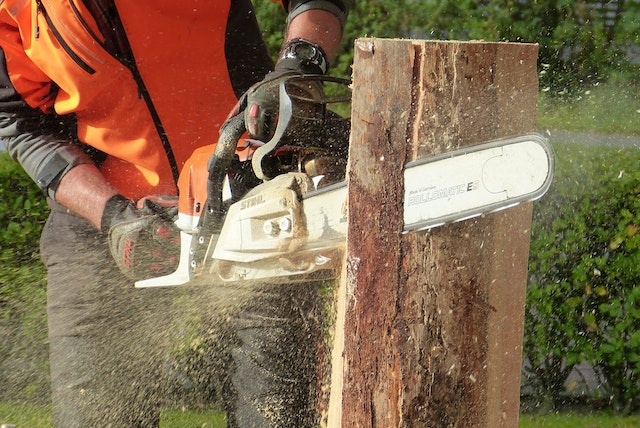The accessories you use with your tools will determine their quality. Failures are frequently caused by poor maintenance of the tools you use. Learn why it is essential that you keep your blades sharp and your tools in good working order.
A saw blade with blunt teeth is one of the most common causes of breakdowns. Half or more of the tungsten carbide points may be missing. Unsurprisingly, the motor or mechanism that powers a device that attempts to force a rotating “metal plate” through a solid block of any material can be damaged. The blades in your saws, planers, routers, and broach machines, among other tools, must be sharp for the tools to function correctly.
Contents
Signs of Blunt Blade
When you use your tool attachment, it will inevitably become worn. The blade dulls over time; when must you replace or sharpen it? There are four signs that your blade is failing while in use:
- Under the blade’s attack, the material begins to splinter. When the blade leaves the material, it may lift small particles, resulting in an uneven and unappealing appearance.
- The noise of the saw will change. The saw’s noise will increase. It will become much noisier, and you will struggle even more with the action you start. The saw’s engine typically makes a louder noise and emits heat. Even a small amount of heat can drastically reduce the lifespan of a motor. Listening to the machine can tell you when the blade is dull if you have a trained ear.
- The rate of cutting has significantly slowed. A sharp blade should cut through any material quickly. Driving the saw through the opening requires a lot more force.
- A slower rotation slows the blade of the saw. When the cutting difficulty rises, the blade’s speed falls, increasing friction and burn marks on the blade and the work material. Aside from the sound of sawing and the sight of smoke, you might notice a burning odor.

Blunt Blades Are Not the Only Machine’s Difficulties.
Remember that dirty blades could cause many initial issues, so don’t assume the cutting tool is dull. Check the blade to see if it needs to be sharpened. Broken teeth or rounded-off edges indicate it is time to sharpen them again. Resin buildup from working with wood could also reduce cutting efficiency, though this is quickly resolved by carefully cleaning the tool. To determine whether a blade is dull or needs maintenance, run your finger along its edge, careful not to touch the teeth.
Another reason for your machine’s failures could be where you store them. Additionally, many people store their machines in basements, attics, and other places with high humidity. Any professional who works with saws will advise you to make a place for your tools, such as a shed. If you don’t, you should think about building one. It’s relatively inexpensive, and it has numerous advantages.
Schedule Maintenance After Work Can Increase the Lifespan of Your Machines
If you work with wood regularly, clean your blades to prevent resin or pitch buildup. If too much buildup accumulates, the blade’s performance and longevity may suffer. Regularly maintaining or cleaning something can extend its useful life and improve its efficiency with little effort.
Without going to the store for something extra, your machines and attachments can easily clean in the following way:
- Gather your supplies, including a drying towel, a cleaning rag, and an old toothbrush. Also, basic home cleaning preparations can help.
- Brush or wipe the blade if you find significant clumps, oil, or dust.
- Leave a degreasing spray on the blade for about 30 minutes to allow it to work its magic and remove the grime. Spritzing the blade at regular intervals will keep it from drying out.
- Remove dust with a brush if you notice any areas that need more attention. If there are any oil residues, use a dump cloth to clean them.
- Wipe off your blade completely with the drying towel.
- Apply some oil to the entire cutting edge.
Home cleaning solutions can also be used to clean your sow. It is a road practice for people who use machines sparingly and only for personal reasons.

Re-lubricating is essential after cleaning – creating an extra layer of protection
After washing, give the blades a good rinse and pat them dry. After cleaning, it is critical to re-lubricate the blade because the procedure will likely remove any lubrication from the blade’s surface. That will keep rust from forming on the blade and make it easier to use. It always is good to keep your blades sharp, but one more essential thing is to put an extra layer of protection with WD-40. You can do it with other sprays, but the point is that specialty lubrication spray that forms a very thin protective layer over the face of the blade is preferable. The non-staining lubricant in the coating aids the cutting process while keeping the blade clean between cleanings.
After cleaning, check double when returning your blade to the saw
When you return the blade, ensure the teeth or cutting edges face forward. Similarly, different circular saw blades have different tooth angles for cutting tasks, so know what you’re doing before you start. Improper installation or using the incorrect blade can damage the workpiece and potentially harm the user.

Should You Resharpen or Buy a New Blade?
We’ve said before that a blunt blade is one of many reasons your machine works less productively. Once you’ve cleaned up and identified all the potential problems, it’s the blade’s turn. People do not always have machines used for sharpening or can’t do it safely. It is always advised to take it to one of the services where they will perform the sharpening. They might advise you to buy a new blade based on their expert opinion. Since the saws are not toys, you should listen to the word of the professionals.
Do schedule maintenance to keep your blades sharp and avoid malfunctions
You don’t buy machines every day. When considering buying them, carefully pick them because they are expensive. It is necessary to use the right tool for the right job. In that way, you can extend the lifespan of your machines. Additionally, machines require proper care and regular maintenance. When cleaning, specific procedures should follow to keep your blades sharp and extend your machines’ lifespan as much as possible.

